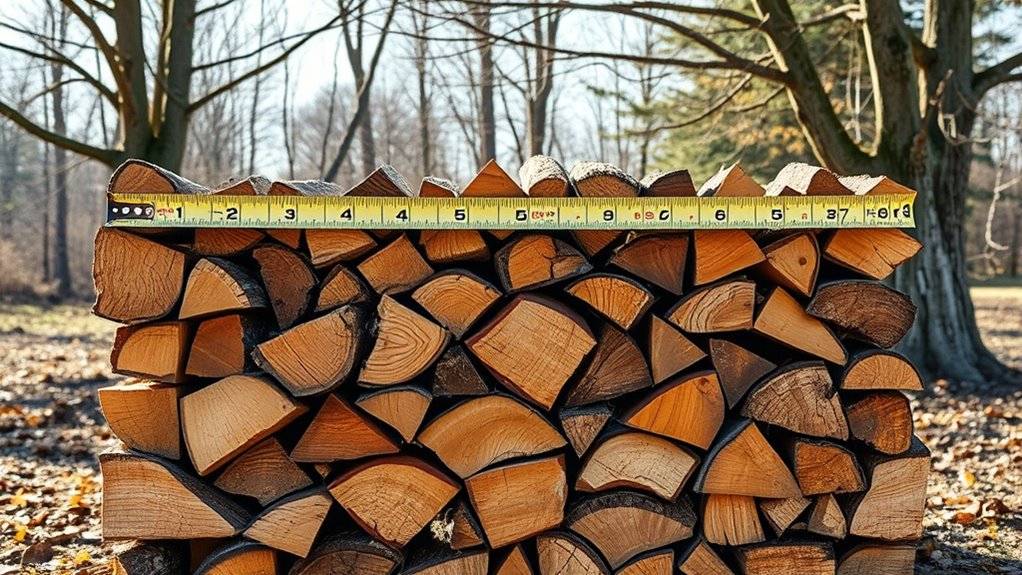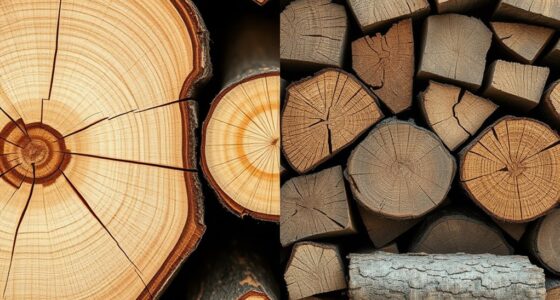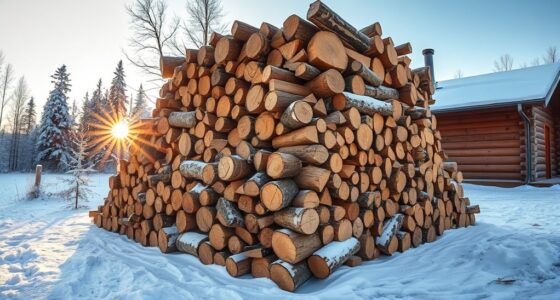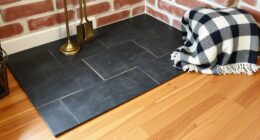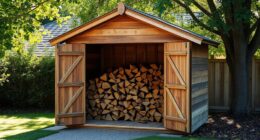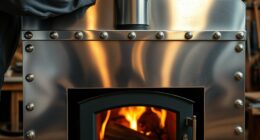To measure a cord of wood accurately, understand it’s a 4x4x8-foot stack, totaling 128 cubic feet. Keep in mind, stacking method and moisture content impact the actual volume—you’ll get more solid wood with proper stacking and well-seasoned, dry wood. Green or uncertified wood may seem like a full cord but can actually be less. For tips on ensuring you’re getting good value, explore what affects real-world measurements and quality.
Key Takeaways
- Understand that a standard cord measures 4x4x8 feet, totaling 128 cubic feet, but actual volume varies with stacking.
- Proper stacking techniques maximize space, promote airflow, and ensure accurate measurement of the wood volume.
- Check moisture content; seasoned wood (<20% moisture) burns more efficiently than green, freshly cut wood.
- Be aware that green wood shrinks during drying, so initial measurements may overestimate dried volume.
- Verify the stacking method and seasoning process to ensure you receive a true, high-quality cord of firewood.

A cord of wood is a standard measurement used to quantify firewood, but understanding exactly what it entails can be confusing. Fundamentally, a cord represents a neatly stacked volume of wood measuring 4 feet high, 4 feet wide, and 8 feet long, totaling 128 cubic feet. However, not all cords are created equal, especially when it comes to firewood stacking. The way you stack your wood can affect how much space it actually takes up, and it influences how easily you can measure and compare different loads. Proper stacking ensures the wood is compact but not overly tight, allowing for good airflow and easier handling. When stacking, think about creating a stable, loose, yet organized pile that maximizes space without compromising safety or accessibility.
Understanding moisture content is equally important when dealing with a cord of wood. Freshly cut or green wood has a high moisture content, often exceeding 50%, which makes it heavy, difficult to burn efficiently, and prone to mold or rot. When measuring a cord, keep in mind that the actual amount of usable firewood depends heavily on the moisture content. Well-seasoned wood, with moisture levels below 20%, burns hotter, cleaner, and more efficiently. If you buy a cord of green or wet wood, you might be getting less effective firewood than expected, even if the volume appears correct. It’s advisable to ask sellers about the moisture content and whether the wood has been properly seasoned before purchase. Properly seasoned wood also settles and shrinks slightly during drying, so what initially appears as a full cord might be somewhat less once fully dried.
Additionally, measuring a cord accurately can be complicated by variations in technology and stacking techniques****, which impact the actual volume and quality of the firewood. Good stacking techniques not only optimize space but also help maintain proper moisture levels by promoting airflow around the logs. This airflow accelerates drying and reduces moisture content, making the wood more efficient for burning. Conversely, poorly stacked wood can trap moisture, leading to mold or decay, and ultimately reducing the quality of your firewood. If you’re buying or selling firewood, always verify the stacking method and ask about the seasoning process. Remember, a well-stacked cord with properly seasoned wood ensures you’re getting the best value and most efficient firewood for your needs.
Frequently Asked Questions
How Do I Estimate a Cord When Wood Is Irregularly Stacked?
To estimate a cord when wood is stacked irregularly, you should first use a consistent stacking technique, like cross-stacking, to create stability. Measure the length, width, and height of the pile, accounting for gaps and irregular shapes by averaging the dimensions. Multiply these measurements (in feet) to get the volume, then divide by 128 to estimate the cords. This method helps you accurately gauge the amount despite irregular stacking.
What Tools Are Best for Measuring a Cord of Wood?
You should use wooden stakes and a tape measure to accurately measure a cord of wood. Drive stakes into the ground at each corner of the stacked wood, then stretch the tape measure between them to determine length, width, and height. These tools help you get precise measurements, especially if the wood is unevenly stacked. With wooden stakes and a tape measure, you’ll confidently verify the volume of your wood supply.
How Does Moisture Content Affect a Cord’s Weight?
Moisture content greatly impacts a cord’s weight, causing significant weight variation. As the moisture impact increases, the wood becomes heavier because water adds to the overall mass. When wood is freshly cut or not properly dried, it retains more moisture, making it weigh more than seasoned or dry wood. You’ll notice this variation when comparing green wood to fully seasoned wood, which is lighter due to lower moisture levels.
Can a Cord Vary in Size Depending on the Wood Type?
Think of a cord like a treasure chest—you might find different sizes depending on the wood type inside. Your experience varies because of wood density and stacking methods; denser woods pack more tightly, making a smaller appearance, while softer woods might seem larger. So, yes, a cord can vary in size, shaped by these factors, meaning you get a different volume based on the wood’s characteristics and how it’s stacked.
Is There a Standard for Measuring a “Face Cord”?
A face cord has no formal standard; it typically measures 8 feet long and 4 feet high, but the width varies based on stacking methods and wood density. To guarantee you’re getting what you expect, clarify how the wood is stacked—whether tight or loose—and confirm the width. This helps you compare offers accurately, considering factors like wood density that affect the amount of wood in each face cord.
Conclusion
Now that you know how to measure a cord of wood, you’ll feel more confident shopping and buying. Think of it like measuring ingredients for a recipe—you want to get it just right. Remember, a standard cord is 128 cubic feet, but always double-check with your seller. With this knowledge, you’ll avoid surprises and make certain you’re getting the right amount for your fire. Happy burning, and may your wood pile stay as perfectly measured as a well-cut diamond!

